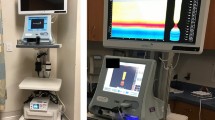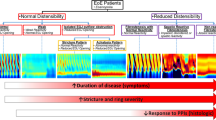Abstract
Objective
The aim of the study was to compare the esophagogastric junction (EGJ) compliance in response to controlled distension in fundoplication (FP) patients and controls using the functional luminal imaging probe (FLIP).
Background
FP aims to replicate normal EGJ distensibility. FLIP is a new technology that uses impedance planimetry to measure intraluminal cross-sectional area (CSA) during controlled distension.
Methods
Ten controls and ten FP patients were studied with high-resolution esophageal pressure topography (HREPT) and then the FLIP placed across the EGJ. Deglutitive and interdeglutitive EGJ distensibility was assessed with volume-controlled distension. The FLIP measured eight CSAs spaced 4 mm apart within a cylindrical saline-filled bag along with the corresponding intrabag pressure.
Results
The EGJ formed an hourglass shape during distensions with the central constriction at the diaphragmatic hiatus. The distensibility of the hiatus was significantly greater during deglutitive relaxation in both subject groups, but FP patients exhibited reduced EGJ distensibility and compliance compared to controls. During the interglutitive period, the corresponding increase in intrabag pressures at larger volumes were also greater in FP patients implying a longer segment of EGJ constriction. The EGJ distensibility characteristics did not correlate with HREPT measures.
Conclusions
FLIP technology was used to compare EGJ distensibility in FP patients and control subjects. The least distensible locus within the EGJ was always at the hiatus. EGJ distensibility was significantly reduced, and the length of constriction increased in FP patients. Future FLIP studies will compare patients with and without post-FP dysphagia and gas bloat, symptoms suggestive of an overly restrictive FP.





Similar content being viewed by others
References
Jenkinson AD, Scott SM, Yazaki E, Fusai G, Walker SM, Kadirkamanathan SS, Evans DF. Compliance measurement of lower esophageal sphincter and esophageal body in achalasia and gastroesophageal reflux disease. Dig Dis Sci 2001;46:1937–1942.
Pandolfino JE, Curry J, Shi G, Joehl RJ, Brasseur JG, Kahrilas PJ. Restoration of normal distensive characteristics of the esophagogastric junction after fundoplication. Ann Surg 2005;242:43–48.
Pandolfino JE, Shi G, Trueworthy B, Kahrilas PJ. Esophagogastric junction opening during relaxation distinguishes nonhernia reflux patients, hernia patients, and normal subjects. Gastroenterology 2003;125:1018–1024.
Pandolfino JE, Shi G, Curry J, Joehl RJ, Brasseur JG, Kahrilas PJ. Esophagogastric junction distensibility: a factor contributing to sphincter incompetence. Am J Physiol Gastrointest Liver Physiol 2002;282:G1052–G1058.
Kahrilas PJ, Lin S, Manka M, Shi G, Joehl RJ. Esophagogastric junction pressure topography after fundoplication. Surgery 2000;127:200–208.
Lord RV, DeMeester SR, Peters JH, Hagen JA, Elyssnia D, Sheth CT, DeMeester TR. Hiatal hernia, lower esophageal sphincter incompetence, and effectiveness of Nissen fundoplication in the spectrum of gastroesophageal reflux disease. J Gastrointest Surg 2008;13:602–610.
Ghosh SK, Kahrilas PJ, Brasseur JG. Liquid in the gastroesophageal segment promotes reflux, but compliance does not: a mathematical modeling study. Am J Physiol Gastrointest Liver Physiol 2008;295:G920–G933.
Orlando RC. Overview of the mechanisms of gastroesophageal reflux. Am J Med 2001;111(Suppl 8A):174S–177S.
Pandolfino JE, Zhang Q, Ghosh SK, Post J, Kwiatek M, Kahrilas PJ. Acidity surrounding the squamocolumnar junction in GERD patients: “acid pocket” versus “acid film”. Am J Gastroenterol 2007;102:2633–2641.
Fletcher J, Wirz A, Young J, Vallance R, McColl KE. Unbuffered highly acidic gastric juice exists at the gastroesophageal junction after a meal. Gastroenterology 2001;121:775–783.
Fletcher J, Wirz A, Henry E, McColl KE. Studies of acid exposure immediately above the gastro-oesophageal squamocolumnar junction: evidence of short segment reflux. Gut 2004;53:168–173.
DeMeester TR, Bonavina L, Albertucci M. Nissen fundoplication for gastroesophageal reflux disease. Evaluation of primary repair in 100 consecutive patients. Ann Surg 1986;204:9–20.
Watson DI, Mathew G, Pike GK, Jamieson GG. Comparison of anterior, posterior and total fundoplication using a viscera model. Dis Esophagus 1997;10:110–114.
Clouse RE, Prakash C. Topographic esophageal manometry: an emerging clinical and investigative approach. Dig Dis 2000;18:64–74.
Kahrilas PJ, Sifrim D. High-resolution manometry and impedance-pH/manometry: valuable tools in clinical and investigational esophagology. Gastroenterology 2008;135:756–769.
Pandolfino JE, Fox MR, Bredenoord AJ, Kahrilas PJ. High-resolution manometry in clinical practice: utilizing pressure topography to classify oesophageal motility abnormalities. Neurogastroenterol Motil 2009;21:796–806.
Harris LD, Pope CE 2nd. “Squeeze” vs. resistance: an evaluation of the mechanism of sphincter competence. J Clin Invest 1964;43:2272–2278.
McMahon BP, Drewes AM, Gregersen H. Functional oesophago-gastric junction imaging. World J Gastroenterol 2006;12:2818–2824.
Gregersen H. Biomechanics of the Gastrointestinal Tract: New Perspectives in Motility Research and Diagnostics. Heidelberg: Springer, 2003, p 268.
McMahon BP, Frokjaer JB, Kunwald P, Liao D, Funch-Jensen P, Drewes AM, Gregersen H. The functional lumen imaging probe (FLIP) for evaluation of the esophagogastric junction. Am J Physiol Gastrointest Liver Physiol 2007;292:G377–G384.
McMahon BP, Frokjaer JB, Liao D, Kunwald P, Drewes AM, Gregersen H. A new technique for evaluating sphincter function in visceral organs: application of the functional lumen imaging probe (FLIP) for the evaluation of the oesophago-gastric junction. Physiol Meas 2005;26:823–836.
Ghosh SK, Pandolfino JE, Zhang Q, Jarosz A, Shah N, Kahrilas PJ. Quantifying esophageal peristalsis with high-resolution manometry: a study of 75 asymptomatic volunteers. Am J Physiol Gastrointest Liver Physiol 2006;290:G988–G997.
Pandolfino JE, Ghosh SK, Zhang Q, Jarosz A, Shah N, Kahrilas PJ. Quantifying EGJ morphology and relaxation with high-resolution manometry: a study of 75 asymptomatic volunteers. Am J Physiol Gastrointest Liver Physiol 2006;290:G1033–G1040.
Pandolfino JE, Kim H, Ghosh SK, Clarke JO, Zhang Q, Kahrilas PJ. High-resolution manometry of the EGJ: an analysis of crural diaphragm function in GERD. Am J Gastroenterol 2007;102:1056–1063.
Ghosh SK, Pandolfino JE, Rice J, Clarke JO, Kwiatek M, Kahrilas PJ. Impaired deglutitive EGJ relaxation in clinical esophageal manometry: a quantitative analysis of 400 patients and 75 controls. Am J Physiol Gastrointest Liver Physiol 2007;293:G878–G885.
Scheffer RC, Samsom M, Haverkamp A, Oors J, Hebbard GS, Gooszen HG. Impaired bolus transit across the esophagogastric junction in postfundoplication dysphagia. Am J Gastroenterol 2005;100:1677–1684.
Pandolfino JE, Ghosh SK, Rice J, Clarke JO, Kwiatek MA, Kahrilas PJ. Classifying esophageal motility by pressure topography characteristics: a study of 400 patients and 75 controls. Am J Gastroenterol 2008;103:27–37.
Mitchell BM, Pandolfino JE, Leslie E, Parks TR, Kwiatek MA, Kahrilas PJ. Measurement of intrabolus pressure (IBP) using high-resolution manometry: normative ranges in the upright and supine position. Gastroenterology 2009;136:A528.
White FM. Fluid Mechanics. New York: McGraw-Hill, 1999.
Acknowledgments
The authors would like to thank Mr. Patrick N. Smith-Ray (Department of Surgery, Feinberg School of Medicine, Northwestern University) for providing patient symptomatology reports and Dr. Sudip K. Ghosh (Department of Medicine, Feinberg School of Medicine, Northwestern University) for initial assistance with the study.
Funding
This work was supported by R01 DC00646 (P.J.K. and J.E.P.) from the Public Health Service and the AGA June and Donald O Castell Esophageal Clinical Research Award (J.E.P.).
Author information
Authors and Affiliations
Corresponding author
Rights and permissions
About this article
Cite this article
Kwiatek, M.A., Kahrilas, P.J., Soper, N.J. et al. Esophagogastric Junction Distensibility After Fundoplication Assessed with a Novel Functional Luminal Imaging Probe. J Gastrointest Surg 14, 268–276 (2010). https://doi.org/10.1007/s11605-009-1086-1
Received:
Accepted:
Published:
Issue Date:
DOI: https://doi.org/10.1007/s11605-009-1086-1




